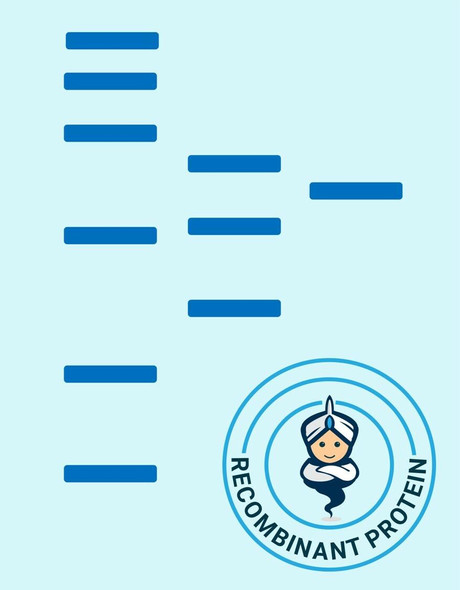Description
| Product Name: | Human KIR2DS4 Recombinant Protein |
| Product Code: | RPPB3787 |
| Size: | 20µg |
| Species: | Human |
| Target: | KIR2DS4 |
| Synonyms: | Killer cell immunoglobulin-like receptor 2DS4, MHC class I NK cell receptor, Natural killer-associated transcript 8, NKAT-8, P58 natural killer cell receptor clone CL-39, p58 NK receptor, CL-17, CD158 antigen-like family member I, CD158i antigen, KIR2DS4, CD158I, KKA3, NKAT8, KIR1D, KIR412, MGC120019, MGC125315, MGC125317. |
| Source: | Escherichia Coli |
| Physical Appearance: | Sterile filtered colorless solution. |
| Formulation: | KIR2DS4 protein solution (1mg/ml) contains 20mM Tris-HCl (pH-7.5). |
| Stability: | Store at 4°C if entire vial will be used within 2-4 weeks. Store, frozen at -20°C for longer periods of time. For long term storage it is recommended to add a carrier protein (0.1% HSA or BSA).Avoid multiple freeze-thaw cycles. |
| Purity: | Greater than 95.0% as determined by SDS-PAGE. |
| Amino Acid Sequence: | MEGVHRKPSF LALPGHLVKS EETVILQCWS DVMFEHFLLH REGKFNNTLH LIGEHHDGVS KANFSIGPMM PVLAGTYRCY GSVPHSPYQL SAPSDPLDMV IIGLYEKPSL SAQPGPTVQA GENVTLSCSS RSSYDMYHLS REGEAHERRL PAVRSINGTF QADFPLGPAT HGGTYRCFGS FRDAPYEWSN SSDPLLVSVT GN |
Killer-cell immunoglobulin-like receptors (KIRs), are a family of cell surface glycoproteins found on Natural Killer (NK) Cells, which are important cells of the immune system. They control the killing function of these cells by interacting with MHC class I molecules, which are expressed on all cell types. This interaction allows them to identify virally infected cells or tumor cells that have a distinctive low level of Class I MHC on their surface. The majority of KIRs are inhibitory, which means that their recognition of MHC suppresses the cytotoxic activity of their NK cell. Only a limited number of KIRs have the capacity to activate cells. The KIR genes are found in a cluster on chromosome 19q13.4 within the 1 Mb leukocyte receptor complex (LRC). KIR molecules are extremely polymorphic, meaning their gene sequences differ significantly between individuals, so that different individuals have different arrays/repertoires of KIR genes.The KIR proteins are categorized by the number of extracellular immunoglobulin domains (2D or 3D) and by whether they have a long (L) or short (S) cytoplasmic domain. KIR proteins with the long cytoplasmic domain transduce inhibitory signals upon ligand binding via an immune tyrosine-based inhibitory motif (ITIM). Whereas KIR proteins with the short cytoplasmic domain lack the ITIM motif and instead associate with the TYRO protein tyrosine kinase binding protein to transduce activating signals. KIR2DS4 is an activating Killer Cell Ig-like Receptor (KIR, previously called p50 KIR, p50.3, cl39, or KAR-K1), which may recognize class I MHC molecules. KIR2DS4 does not inhibit the activity of NK cells.
Recombinant Human KIR2DS4 produced in E.Coli is a single, non-glycosylated polypeptide chain (23-223 aa) containing a total of 202 amino acids and having a molecular mass of 22.2kDa.The KIR2DS4 is purified by proprietary chromatographic techniques.
| UniProt Protein Function: | KIR2DS4: Receptor on natural killer (NK) cells for HLA-C alleles. Does not inhibit the activity of NK cells. Belongs to the immunoglobulin superfamily. |
| UniProt Protein Details: | Protein type:Membrane protein, integral Chromosomal Location of Human Ortholog: 19q13.4 Cellular Component: integral to plasma membrane; plasma membrane Biological Process: innate immune response |
| NCBI Summary: | Killer cell immunoglobulin-like receptors (KIRs) are transmembrane glycoproteins expressed by natural killer cells and subsets of T cells. The KIR genes are polymorphic and highly homologous and they are found in a cluster on chromosome 19q13.4 within the 1 Mb leukocyte receptor complex (LRC). The gene content of the KIR gene cluster varies among haplotypes, although several "framework" genes are found in all haplotypes (KIR3DL3, KIR3DP1, KIR3DL4, KIR3DL2). The KIR proteins are classified by the number of extracellular immunoglobulin domains (2D or 3D) and by whether they have a long (L) or short (S) cytoplasmic domain. KIR proteins with the long cytoplasmic domain transduce inhibitory signals upon ligand binding via an immune tyrosine-based inhibitory motif (ITIM), while KIR proteins with the short cytoplasmic domain lack the ITIM motif and instead associate with the TYRO protein tyrosine kinase binding protein to transduce activating signals. The ligands for several KIR proteins are subsets of HLA class I molecules; thus, KIR proteins are thought to play an important role in regulation of the immune response. [provided by RefSeq, Jul 2008] |
| UniProt Code: | P43632 |
| NCBI GenInfo Identifier: | 2828511 |
| NCBI Gene ID: | 3809 |
| NCBI Accession: | P43632.2 |
| UniProt Secondary Accession: | P43632,Q6H2G7, |
| UniProt Related Accession: | P43632 |
| Molecular Weight: | 304 |
| NCBI Full Name: | Killer cell immunoglobulin-like receptor 2DS4 |
| NCBI Synonym Full Names: | killer cell immunoglobulin-like receptor, two domains, short cytoplasmic tail, 4 |
| NCBI Official Symbol: | KIR2DS4�� |
| NCBI Official Synonym Symbols: | KKA3; KIR1D; NKAT8; CD158I; KIR412; NKAT-8; KIR2DS1�� |
| NCBI Protein Information: | killer cell immunoglobulin-like receptor 2DS4; KIR antigen 2DS4; killer Ig receptor; p58 NK receptor CL-39/CL-17; MHC class I NK cell receptor; killer inhibitory receptor 4-1-2; CD158 antigen-like family member I; natural killer-associated transcript 8; natural killer cell inhibitory receptor; P58 natural killer cell receptor clones CL-39/CL-17; killer cell immunoglobulin-like receptor two domains short cytoplasmic tail 1 |
| UniProt Protein Name: | Killer cell immunoglobulin-like receptor 2DS4 |
| UniProt Synonym Protein Names: | CD158 antigen-like family member I; MHC class I NK cell receptor; Natural killer-associated transcript 8; NKAT-8; P58 natural killer cell receptor clones CL-39/CL-17; p58 NK receptor CL-39/CL-17; CD_antigen: CD158i |
| Protein Family: | Killer cell immunoglobulin-like receptor |
| UniProt Gene Name: | KIR2DS4�� |
| UniProt Entry Name: | KI2S4_HUMAN |






